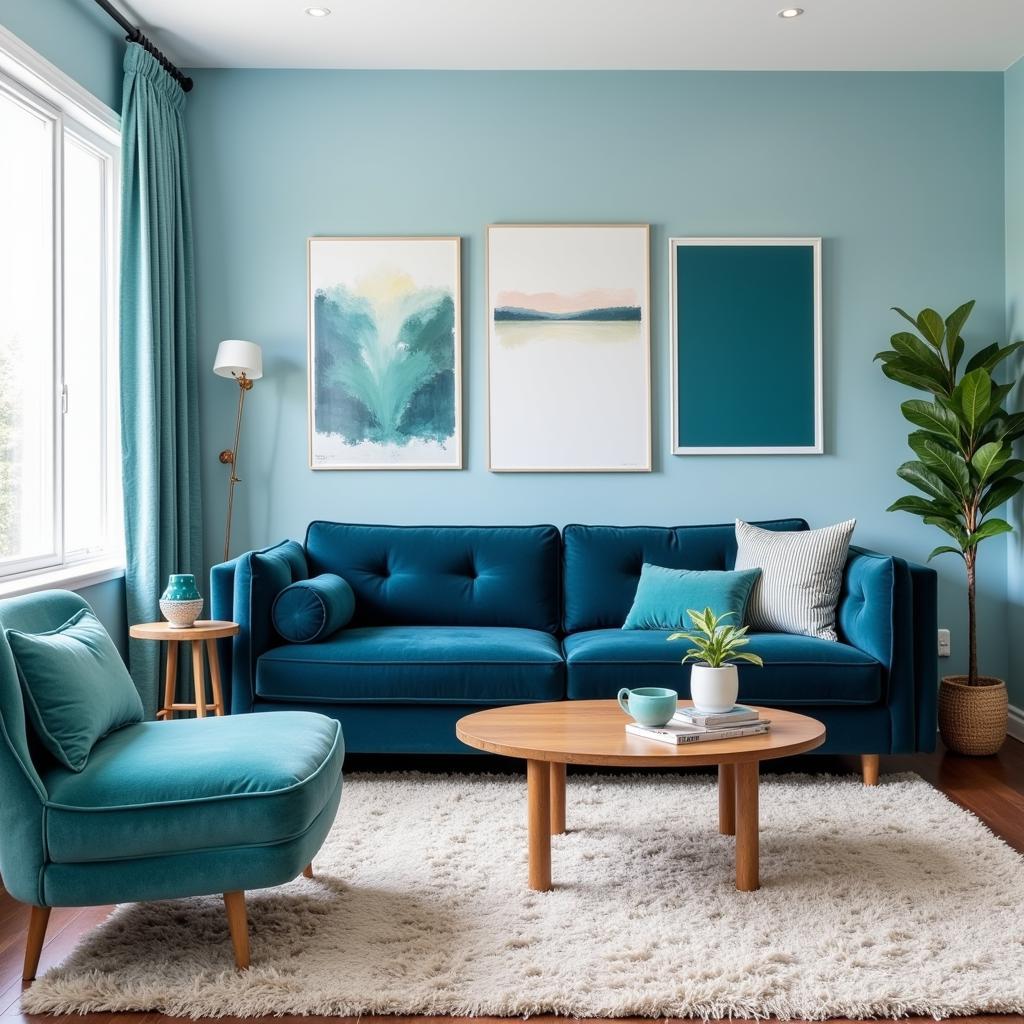Light blue: the color of a clear summer sky, a tranquil ocean, and a symbol of serenity. It’s a popular choice for home decor for a reason. But when it comes to choosing colors that go well with light blue, many find themselves lost in a sea of options. Fear not, color enthusiasts! This guide will equip you with the knowledge to confidently pair light blue with other shades, unlocking a world of captivating design possibilities.
Understanding the Versatility of Light Blue
Light blue is incredibly versatile. It can act as a neutral backdrop for bolder hues or take center stage as the star of the show. Its ability to evoke feelings of calmness and airiness makes it ideal for various spaces, from bedrooms to living rooms.
Complementary Colors: Creating a Dynamic Contrast
In color theory, complementary colors lie opposite each other on the color wheel. When paired together, they create a vibrant and energetic contrast. For light blue, its complementary color is orange.
Don’t shy away from this seemingly bold pairing! Orange, in its various shades like coral or peach, can add warmth and personality to a light blue space.
Here’s how to incorporate orange:
- Accent Wall: Paint a single wall in a warm shade of orange to create a focal point in a light blue room.
- Textiles: Introduce pops of orange through throw pillows, rugs, or curtains.
- Artwork: Choose artwork featuring orange hues to tie the color palette together.
Analogous Colors: Achieving a Harmonious Flow
Analogous colors sit next to each other on the color wheel, creating a sense of harmony and visual cohesion. For light blue, consider pairing it with shades of green and purple.
- Green: Light blue and green evoke a natural and refreshing feel, reminiscent of a tranquil garden. Think sage green, mint green, or even a deep forest green for a sophisticated touch.
- Purple: Pairing light blue with lavender or lilac can create a soft and romantic atmosphere, perfect for bedrooms or bathrooms.
Tips for using analogous colors:
- Gradient Walls: Create a soothing effect by painting walls in a gradient of light blue, green, and purple.
- Textile Play: Experiment with different textures and patterns in your chosen colors to add depth and interest.
- Accessorize Wisely: Use accessories like vases, candles, and decorative objects to incorporate your analogous shades.
Monochromatic Magic: Exploring Shades of Blue
For a timeless and elegant look, consider a monochromatic color scheme using varying shades of blue. This creates a calming and cohesive atmosphere.
- Navy Blue: Incorporate navy blue through furniture pieces like a sofa or headboard to ground the light blue and add a touch of sophistication.
- Teal: Add a splash of vibrancy with teal accents in the form of throw pillows, artwork, or even a statement chair.
- Turquoise: For a bolder look, incorporate turquoise through decorative items like vases, lamps, or even a statement rug.
Creating a Monochromatic Blue Space:
- Varying Shades: Use a mix of light blue, medium blue, and dark blue to create depth and dimension.
- Texture is Key: Incorporate different textures like velvet, linen, and wood to add visual interest.
- Metallic Accents: Introduce metallic accents like gold or silver through picture frames, lamps, or hardware for a touch of glamour.
 Monochromatic Blue Living Room
Monochromatic Blue Living Room
Neutral Companions: Enhancing Light Blue’s Serenity
Neutral colors like white, gray, and beige create a clean and classic backdrop for light blue, allowing it to shine.
- White: Pairing light blue with white creates a crisp and airy feel, perfect for smaller spaces.
- Gray: Gray adds a touch of sophistication and works particularly well with cooler shades of light blue.
- Beige: For a warmer and more inviting atmosphere, pair light blue with beige or cream.
Tips for Using Neutrals:
- Balance is Key: Ensure a balanced distribution of light blue and your chosen neutral to prevent one color from overpowering the other.
- Add Pops of Color: Introduce pops of color through accessories to add personality and prevent the space from feeling sterile.
- Consider the Mood: Choose your neutral based on the mood you want to create. White for a fresh and airy feel, gray for a sophisticated touch, and beige for warmth.
Creating Your Perfect Light Blue Palette
Now that you’re familiar with the colors that go well with light blue, it’s time to create your perfect palette. Remember these tips:
- Consider the Room’s Purpose: The function of the room should influence your color choices. For example, a bedroom might benefit from calming blues and greens, while a living room could handle a more vibrant palette with pops of orange.
- Test Your Colors: Before committing to a color scheme, test your chosen colors in the actual room you’ll be painting. Light can significantly impact how colors appear.
- Trust Your Instincts: Most importantly, have fun and experiment! Don’t be afraid to try different combinations until you find the perfect palette that reflects your style and makes your space feel like home.
Need Help Finding the Perfect Color Combinations?
Contact Color Box Hanoi at 0373298888 or email us at [email protected]. Our team of color experts is ready to assist you in creating a space you’ll love. Visit our showroom at 86 Cầu Giấy, Hà Nội to explore our vast selection of paint colors and receive personalized advice.

